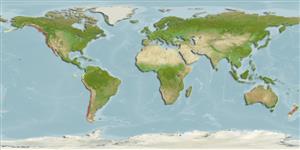Environment: milieu / climate zone / depth range / distribution range
Ekologi
laut dasar (demersal); kisaran kedalaman 0 - 49 m (Ref. 2850). Subtropical; 60°N -
Eastern Pacific: Kodiak Island, Alaska to Point San Carlos, central Baja California, Mexico.
Size / Weight / umur
Maturity: Lm ? range ? - ? cm
Max length : 25.0 cm TL jantan/; (Ref. 4925); Umur maksimum dilaporkan: 8 Tahun (Ref. 56049)
deskripsi pendek
Kunci identifiaksi (pengenalan) | Morfologi | Morfometrik
Duri punggung (Keseluruhan (total)) : 16; duri punggung lunak (Keseluruhan (total)) : 14 - 16; Duri dubur: 3 - 4; Sirip dubur lunak: 12 - 13; vertebrata, bertulang belakang: 36 - 39. Dorsal rayed part higher than spinous part. Caudal gently rounded. Anal notched between spinous and rayed parts, well incised (Ref. 6885). Head with scales; one fleshy cirrus above each eye and a pair on the occiput; gill membranes joined, free of isthmus. Body with 7 dark vertical bands. Pelvic fin of moderate length, not reaching the anus (Ref. 48751).
Found in rocky areas, from the intertidal to 49 m (Ref. 2850). Sleeps on the oral disc, leaving the anemone (Urticina lofotensis) by day but returning every night (Ref. 45560). Commonly encountered hovering motionless by divers (Ref. 2850). Feeds on crustaceans, polychaetes, small mollusks and bryozoans (Ref. 4930). Neither anterolateral glandular grooves nor venom gland is present (Ref. 57406).
Eschmeyer, W.N., E.S. Herald and H. Hammann, 1983. A field guide to Pacific coast fishes of North America. Boston (MA, USA): Houghton Mifflin Company. xii+336 p. (Ref. 2850)
Status IUCN Red List (Ref. 130435: Version 2024-2)
penggunaan manusia
Alat, peralatan
laporan khas
muat turun XML
Sumber internet
Estimates based on models
Preferred temperature (Ref.
123201): 7.9 - 13.8, mean 10.4 °C (based on 128 cells).
Phylogenetic diversity index (Ref.
82804): PD
50 = 1.0002 [Uniqueness, from 0.5 = low to 2.0 = high].
Bayesian length-weight: a=0.01122 (0.00514 - 0.02450), b=3.04 (2.87 - 3.21), in cm total length, based on all LWR estimates for this body shape (Ref.
93245).
Trophic level (Ref.
69278): 3.4 ±0.42 se; based on food items.
Daya lenting (Ref.
120179): sedang, Waktu penggandaan populasi minimum 1.4 - 4.4 tahun (tm=2.5; tmax=8; Fec=112,000).
Fishing Vulnerability (Ref.
59153): Low vulnerability (15 of 100).
Nutrients (Ref.
124155): Calcium = 139 [53, 289] mg/100g; Iron = 1.29 [0.59, 3.09] mg/100g; Protein = 18.5 [16.5, 20.5] %; Omega3 = 0.513 [0.242, 1.348] g/100g; Selenium = 21.1 [11.2, 53.5] μg/100g; VitaminA = 18.4 [6.6, 50.9] μg/100g; Zinc = 0.95 [0.65, 1.46] mg/100g (wet weight);
